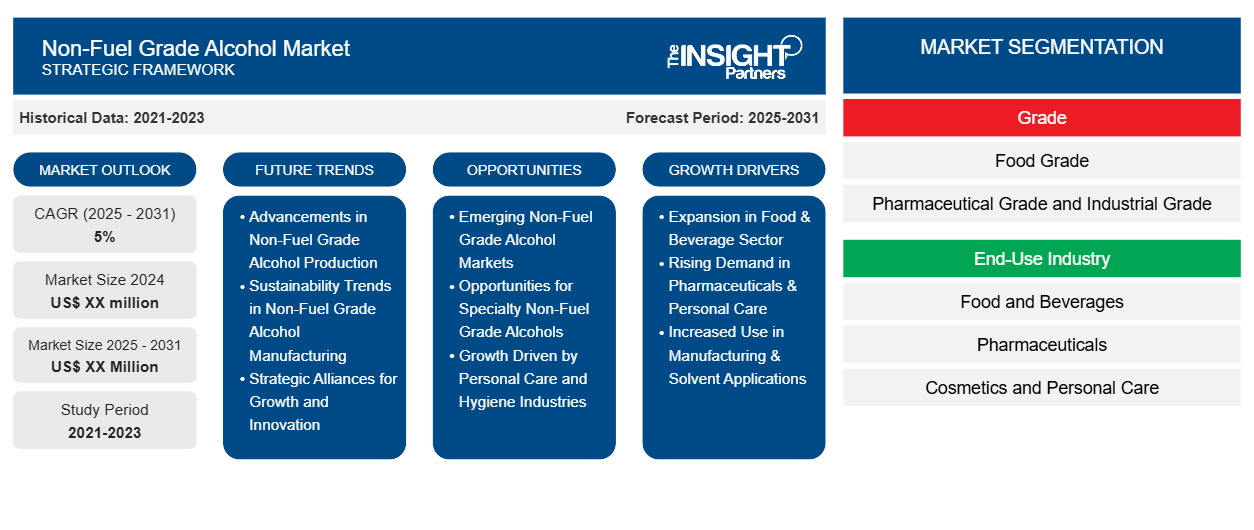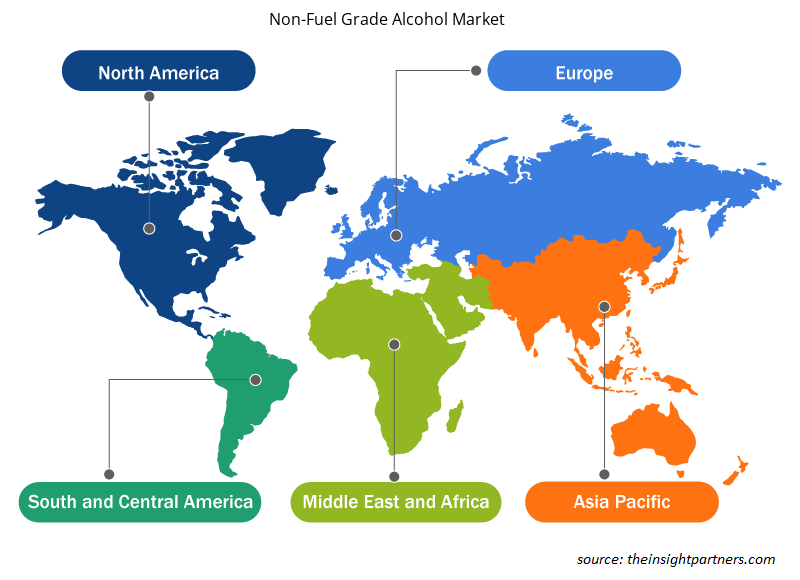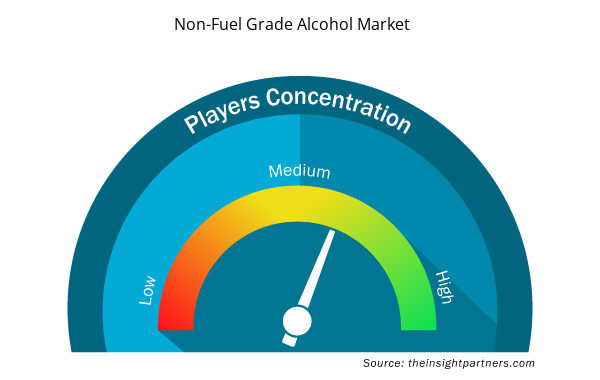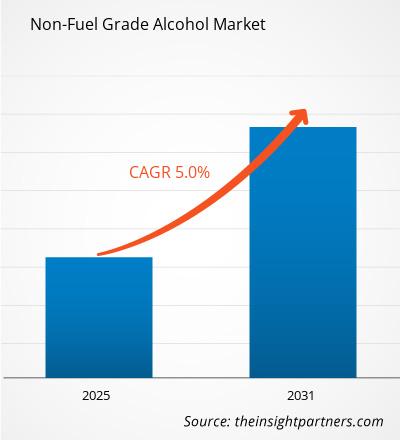Le marché de l'alcool de qualité non combustible devrait enregistrer un TCAC de 5 % de 2024 à 2031, avec une taille de marché passant de XX millions USD en 2024 à XX millions USD d'ici 2031.
Le rapport est segmenté par catégorie (qualité alimentaire, qualité pharmaceutique et qualité industrielle). Le rapport présente en outre une analyse basée sur l'industrie d'utilisation finale (aliments et boissons, produits pharmaceutiques, cosmétiques et soins personnels, produits chimiques et autres). L'analyse mondiale est ensuite décomposée au niveau régional et par principaux pays. La taille du marché et les prévisions aux niveaux mondial, régional et national pour tous les segments de marché clés sont couvertes dans le cadre du rapport. Le rapport offre la valeur en USD pour l'analyse et les segments ci-dessus. Le rapport fournit des statistiques clés sur l'état du marché des principaux acteurs du marché et offre des tendances et des opportunités de marché.
Objectif du rapport
Le rapport sur le marché des alcools non combustibles de The Insight Partners vise à décrire le paysage actuel et la croissance future, les principaux facteurs moteurs, les défis et les opportunités. Cela fournira des informations à diverses parties prenantes commerciales, telles que :
- Fournisseurs/fabricants de technologie : pour comprendre l’évolution de la dynamique du marché et connaître les opportunités de croissance potentielles, leur permettant de prendre des décisions stratégiques éclairées.
- Investisseurs : Effectuer une analyse complète des tendances concernant le taux de croissance du marché, les projections financières du marché et les opportunités qui existent tout au long de la chaîne de valeur.
- Organismes de réglementation : Réglementer les politiques et surveiller les activités du marché dans le but de minimiser les abus, de préserver la confiance des investisseurs et de maintenir l’intégrité et la stabilité du marché.
Segmentation du marché des alcools non destinés à l'essence
Grade
- Qualité alimentaire
- Qualité pharmaceutique et qualité industrielle
Secteur d'utilisation finale
- Alimentation et boissons
- Médicaments
- Cosmétiques et soins personnels
- Produits chimiques et autres
Personnalisez ce rapport en fonction de vos besoins
Vous bénéficierez d'une personnalisation gratuite de n'importe quel rapport, y compris de certaines parties de ce rapport, d'une analyse au niveau des pays, d'un pack de données Excel, ainsi que de superbes offres et réductions pour les start-ups et les universités.
Marché des alcools non destinés à l'essence : perspectives stratégiques

- Obtenez les principales tendances clés du marché de ce rapport.Cet échantillon GRATUIT comprendra une analyse de données, allant des tendances du marché aux estimations et prévisions.
Facteurs de croissance du marché des alcools non destinés à l'essence
- Expansion dans le secteur de l'alimentation et des boissons : L'utilisation croissante de l'alcool dans le secteur de l'alimentation et des boissons continue d'être l'un des facteurs importants qui alimentent la croissance du marché de l'alcool non combustible. L'éthanol est un alcool non combustible essentiel largement utilisé dans la transformation des aliments comme conservateur, agent aromatisant et solvant. Le savoir-faire des boissons artisanales et la disponibilité de boissons prêtes à boire (RTD) de qualité supérieure, souvent mélangées à de l'alcool et des liqueurs aromatisées spiritueuses, augmentent la demande d'alcool non combustible de qualité supérieure.RTD)-often blended in alcohol and spirituous flavored liquors-increasing demand for non-fuel grade alcohol of high standards.
- Demande croissante dans les produits pharmaceutiques et de soins personnels : Une autre catégorie d'alcools non combustibles où l'éthanol et l'alcool isopropylique ont le plus d'applications est celle des produits pharmaceutiques et de soins personnels. Les alcools se trouvent dans les frictions, les solvants et également pour la désinfection. Le marché mondial des matières premières a été modifié par l'adoption de mesures sanitaires pour assurer la sécurité en raison de maladies pandémiques comme la COVID-19, car les gens maintiennent des normes de propreté saines, augmentant la consommation de désinfectants et de désinfectants. Cette tendance va probablement persister, ce qui explique l'utilisation d'alcools non combustibles dans l'utilisation industrielle, ce qui crée une demande accrue.
- Utilisation accrue dans les applications de fabrication et de solvants : les solvants alcooliques non combustibles sont essentiels dans toutes les installations, y compris les revêtements, les adhésifs ou même les agents de nettoyage. Avec la croissance du secteur manufacturier dans les pays en développement rapide, la consommation de solvants augmente, ce qui profite également au marché des alcools non combustibles. À mesure que les méthodes de production évoluent avec de nouvelles techniques et machines pour maximiser la production, l'utilisation d'alcools non combustibles dans les processus de fabrication augmentera également.
Tendances futures du marché des alcools non-carburants
- Progrès dans la production d'alcool de qualité non combustible : L'efficacité et la durabilité de la production de boissons alcoolisées de qualité non combustible se sont considérablement améliorées grâce aux technologies récentes. L'optimisation de la fermentation et l'utilisation d'autres processus biochimiques ont été adoptées pour produire de l'éthanol et d'autres types d'alcool. Ces technologies visent à réduire les coûts de production et à réduire les effets néfastes de la pollution associée à la production sur le déroulement des pratiques, une tendance de la société moderne pour les questions de durabilité des industries chimiques.
- Tendances en matière de développement durable dans la fabrication d’alcools non destinés aux carburants : Le souci de durabilité dans la production et la vente d’alcools non destinés aux carburants est perceptible sur le marché actuel. De plus en plus d’entreprises se tournent vers des méthodes de production d’alcool qui incluent l’utilisation de matières premières issues de cultures et le recyclage d’autres alcools. La raison pour laquelle le marché s’oriente vers cet approvisionnement en alcool plus durable est due à la demande de solutions écologiques de la part des consommateurs et aux réglementations limitant les émissions de gaz à effet de serre. Ces évolutions des marchés, associées à des pratiques durables dans l’adoption de processus de fabrication écologiques, propulseront certains fabricants au premier plan de ce marché.
- Alliances stratégiques pour la croissance et l'innovation : Les acteurs du marché des alcools non combustibles concluent des alliances stratégiques pour améliorer leurs produits et services et accroître leur présence. Les partenariats stratégiques entre les fabricants d'alcool, les entreprises technologiques et les établissements de recherche favorisent le développement et créent de nouveaux marchés pour les alcools non combustibles. Ces stratégies aident à rester pertinents dans un environnement commercial caractérisé par des changements technologiques rapides.
Opportunités de marché pour les alcools non destinés à l'essence
- Marchés émergents des alcools non-carburants : De nouveaux marchés des alcools non-carburants apparaissent dans des pays comme l'Asie-Pacifique et l'Amérique latine, qui présentent un grand potentiel de croissance. Ces régions sont réticentes à une croissance économique et une industrialisation trop importantes, mais si elles sont menées à bien, les alcools non-carburants devraient s'infiltrer dans tous les autres domaines qui nécessitent leur utilisation et donc la demande pour ces produits augmentera. L'expansion sera observée par les entreprises capables de trouver la demande sur ces marchés et de localiser leur produit.
- Opportunités pour les alcools spéciaux non destinés aux carburants : Il existe de nombreuses possibilités pour les fabricants en raison des alcools spéciaux non destinés aux carburants qui répondent à des applications sélectionnées. Par exemple, on peut entrer sur le marché en recherchant des alcools de haute pureté pour les produits pharmaceutiques ou des structures d'alcool uniques pour certaines applications industrielles. En modifiant les produits en fonction des différentes demandes industrielles, il sera possible de gagner un marché plus vaste et d'augmenter les profits.
- Croissance tirée par les industries des soins personnels et de l'hygiène : La croissance des industries des soins personnels et de l'hygiène crée une perspective attrayante pour le marché des alcools de qualité non combustible. Le besoin du marché pour des produits tels que les désinfectants pour les mains et les désinfectants crée une marge de manœuvre pour que les fabricants se tournent vers les alcools de qualité non combustible pour les utiliser dans les produits avec de nouvelles stratégies. Cela permettra de commercialiser la nécessité de développer ces produits fabriqués dans ce segment, car les attentes des clients en matière d'efficacité et de sécurité ne seront pas compromises.
Aperçu régional du marché des alcools non-carburants
Les tendances et facteurs régionaux influençant le marché des alcools non combustibles tout au long de la période de prévision ont été expliqués en détail par les analystes d’Insight Partners. Cette section traite également des segments et de la géographie du marché des alcools non combustibles en Amérique du Nord, en Europe, en Asie-Pacifique, au Moyen-Orient et en Afrique, ainsi qu’en Amérique du Sud et en Amérique centrale.

- Obtenez les données régionales spécifiques au marché des alcools non combustibles
Portée du rapport sur le marché des alcools non combustibles
| Attribut de rapport | Détails |
|---|---|
| Taille du marché en 2024 | XX millions de dollars américains |
| Taille du marché d'ici 2031 | XX millions de dollars américains |
| Taux de croissance annuel composé mondial (2025-2031) | 5% |
| Données historiques | 2021-2023 |
| Période de prévision | 2025-2031 |
| Segments couverts | Par niveau
|
| Régions et pays couverts | Amérique du Nord
|
| Leaders du marché et profils d'entreprises clés |
|
Densité des acteurs du marché des alcools non-carburants : comprendre son impact sur la dynamique commerciale
Le marché des alcools non combustibles connaît une croissance rapide, tirée par la demande croissante des utilisateurs finaux en raison de facteurs tels que l'évolution des préférences des consommateurs, les avancées technologiques et une plus grande sensibilisation aux avantages du produit. À mesure que la demande augmente, les entreprises élargissent leurs offres, innovent pour répondre aux besoins des consommateurs et capitalisent sur les tendances émergentes, ce qui alimente davantage la croissance du marché.
La densité des acteurs du marché fait référence à la répartition des entreprises ou des sociétés opérant sur un marché ou un secteur particulier. Elle indique le nombre de concurrents (acteurs du marché) présents sur un marché donné par rapport à sa taille ou à sa valeur marchande totale.
Les principales entreprises opérant sur le marché des alcools non destinés aux carburants sont :
- Archer Daniels Midl et compagnie
- Cargill, société incorporée
- CropEnergies AG
- Godavari Biorefineries Ltd
- LyondellBasell Industries Holdings BV
Avis de non-responsabilité : les sociétés répertoriées ci-dessus ne sont pas classées dans un ordre particulier.

- Obtenez un aperçu des principaux acteurs du marché des alcools non combustibles
Principaux arguments de vente
- Couverture complète : Le rapport couvre de manière exhaustive l’analyse des produits, des services, des types et des utilisateurs finaux du marché des alcools non combustibles, offrant un paysage holistique.
- Analyse d’experts : Le rapport est compilé sur la base d’une compréhension approfondie des experts et analystes du secteur.
- Informations à jour : Le rapport garantit la pertinence commerciale en raison de sa couverture des informations récentes et des tendances des données.
- Options de personnalisation : ce rapport peut être personnalisé pour répondre aux exigences spécifiques du client et s'adapter parfaitement aux stratégies commerciales.
Le rapport de recherche sur le marché des alcools non combustibles peut donc aider à ouvrir la voie au décodage et à la compréhension du scénario de l’industrie et des perspectives de croissance. Bien qu’il puisse y avoir quelques préoccupations valables, les avantages globaux de ce rapport ont tendance à l’emporter sur les inconvénients.
- Analyse historique (2 ans), année de base, prévision (7 ans) avec TCAC
- Analyse PEST et SWO
- Taille du marché Valeur / Volume - Mondial, Régional, Pays
- Industrie et paysage concurrentiel
- Ensemble de données Excel


- Underwater Connector Market
- Pharmacovigilance and Drug Safety Software Market
- Rugged Servers Market
- Digital Pathology Market
- Hydrogen Compressors Market
- Smart Parking Market
- Playout Solutions Market
- Personality Assessment Solution Market
- Nuclear Waste Management System Market
- Employment Screening Services Market

Report Coverage
Revenue forecast, Company Analysis, Industry landscape, Growth factors, and Trends

Segment Covered
This text is related
to segments covered.

Regional Scope
North America, Europe, Asia Pacific, Middle East & Africa, South & Central America

Country Scope
This text is related
to country scope.
Questions fréquemment posées
Innovation in production processes is expected to be the key market trends
The report can be delivered in PDF/Word format, we can also share excel data sheet based on request.
On the basis of geography, the non-fuel grade alcohol market is classified into North America, Europe, Asia Pacific, Middle East and Africa, and South and Central America
Archer Daniels Midland Company; Cargill Inc; Lallemand Inc; Green Plains Inc; Godavari Biorefineries Ltd are some of the key players operating in the non-fuel grade alcohol market
Increasing demand in the food and beverage sector is driving the market growth
The Non-Fuel Grade Alcohol Market is estimated to witness a CAGR of 5% from 2023 to 2031
Trends and growth analysis reports related to Chemicals and Materials : READ MORE..
1. Archer Daniels Midl and Company2. Cargill, Incorporated3. CropEnergies AG4. Godavari Biorefineries Ltd5. LyondellBasell Industries Holdings BV6. Merck KGaA7. Pannonia Bio8. Sasol9. Solvay10. Wilmar Bioethanol
The Insight Partners performs research in 4 major stages: Data Collection & Secondary Research, Primary Research, Data Analysis and Data Triangulation & Final Review.
- Data Collection and Secondary Research:
As a market research and consulting firm operating from a decade, we have published and advised several client across the globe. First step for any study will start with an assessment of currently available data and insights from existing reports. Further, historical and current market information is collected from Investor Presentations, Annual Reports, SEC Filings, etc., and other information related to company’s performance and market positioning are gathered from Paid Databases (Factiva, Hoovers, and Reuters) and various other publications available in public domain.
Several associations trade associates, technical forums, institutes, societies and organization are accessed to gain technical as well as market related insights through their publications such as research papers, blogs and press releases related to the studies are referred to get cues about the market. Further, white papers, journals, magazines, and other news articles published in last 3 years are scrutinized and analyzed to understand the current market trends.
- Primary Research:
The primarily interview analysis comprise of data obtained from industry participants interview and answers to survey questions gathered by in-house primary team.
For primary research, interviews are conducted with industry experts/CEOs/Marketing Managers/VPs/Subject Matter Experts from both demand and supply side to get a 360-degree view of the market. The primary team conducts several interviews based on the complexity of the markets to understand the various market trends and dynamics which makes research more credible and precise.
A typical research interview fulfils the following functions:
- Provides first-hand information on the market size, market trends, growth trends, competitive landscape, and outlook
- Validates and strengthens in-house secondary research findings
- Develops the analysis team’s expertise and market understanding
Primary research involves email interactions and telephone interviews for each market, category, segment, and sub-segment across geographies. The participants who typically take part in such a process include, but are not limited to:
- Industry participants: VPs, business development managers, market intelligence managers and national sales managers
- Outside experts: Valuation experts, research analysts and key opinion leaders specializing in the electronics and semiconductor industry.
Below is the breakup of our primary respondents by company, designation, and region:

Once we receive the confirmation from primary research sources or primary respondents, we finalize the base year market estimation and forecast the data as per the macroeconomic and microeconomic factors assessed during data collection.
- Data Analysis:
Once data is validated through both secondary as well as primary respondents, we finalize the market estimations by hypothesis formulation and factor analysis at regional and country level.
- Macro-Economic Factor Analysis:
We analyse macroeconomic indicators such the gross domestic product (GDP), increase in the demand for goods and services across industries, technological advancement, regional economic growth, governmental policies, the influence of COVID-19, PEST analysis, and other aspects. This analysis aids in setting benchmarks for various nations/regions and approximating market splits. Additionally, the general trend of the aforementioned components aid in determining the market's development possibilities.
- Country Level Data:
Various factors that are especially aligned to the country are taken into account to determine the market size for a certain area and country, including the presence of vendors, such as headquarters and offices, the country's GDP, demand patterns, and industry growth. To comprehend the market dynamics for the nation, a number of growth variables, inhibitors, application areas, and current market trends are researched. The aforementioned elements aid in determining the country's overall market's growth potential.
- Company Profile:
The “Table of Contents” is formulated by listing and analyzing more than 25 - 30 companies operating in the market ecosystem across geographies. However, we profile only 10 companies as a standard practice in our syndicate reports. These 10 companies comprise leading, emerging, and regional players. Nonetheless, our analysis is not restricted to the 10 listed companies, we also analyze other companies present in the market to develop a holistic view and understand the prevailing trends. The “Company Profiles” section in the report covers key facts, business description, products & services, financial information, SWOT analysis, and key developments. The financial information presented is extracted from the annual reports and official documents of the publicly listed companies. Upon collecting the information for the sections of respective companies, we verify them via various primary sources and then compile the data in respective company profiles. The company level information helps us in deriving the base number as well as in forecasting the market size.
- Developing Base Number:
Aggregation of sales statistics (2020-2022) and macro-economic factor, and other secondary and primary research insights are utilized to arrive at base number and related market shares for 2022. The data gaps are identified in this step and relevant market data is analyzed, collected from paid primary interviews or databases. On finalizing the base year market size, forecasts are developed on the basis of macro-economic, industry and market growth factors and company level analysis.
- Data Triangulation and Final Review:
The market findings and base year market size calculations are validated from supply as well as demand side. Demand side validations are based on macro-economic factor analysis and benchmarks for respective regions and countries. In case of supply side validations, revenues of major companies are estimated (in case not available) based on industry benchmark, approximate number of employees, product portfolio, and primary interviews revenues are gathered. Further revenue from target product/service segment is assessed to avoid overshooting of market statistics. In case of heavy deviations between supply and demand side values, all thes steps are repeated to achieve synchronization.
We follow an iterative model, wherein we share our research findings with Subject Matter Experts (SME’s) and Key Opinion Leaders (KOLs) until consensus view of the market is not formulated – this model negates any drastic deviation in the opinions of experts. Only validated and universally acceptable research findings are quoted in our reports.
We have important check points that we use to validate our research findings – which we call – data triangulation, where we validate the information, we generate from secondary sources with primary interviews and then we re-validate with our internal data bases and Subject matter experts. This comprehensive model enables us to deliver high quality, reliable data in shortest possible time.

 Obtenez un échantillon gratuit pour ce rapport
Obtenez un échantillon gratuit pour ce rapport